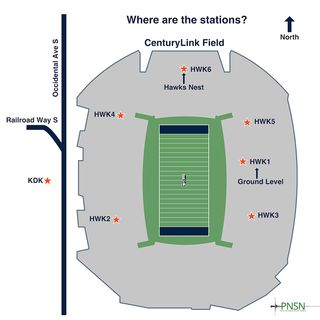Seahawks Score Touchdown, and Fans Shake Earthquake Monitors

Seattle Seahawks fans' enthusiastic stomping and cheering at CenturyLink Field during the NFL playoff season is so powerful it can be felt by sensitive earthquake-detection equipment. And seismologists made special preparations to record the crowd noise that accompanied an important game on Saturday (Jan. 7) against the Detroit Lions.
The Pacific Northwest Seismic Network (PNSN) installed an array of seismometers (equipment that visualizes shaking as waves) at several stations throughout the stadium, in anticipation of the tremors that Seahawks followers have become famous for generating. PNSN shared web displays of the wave readings so that viewers at home could track the boisterous celebrations in real time — in fact, the seismographs were visible several seconds before the cheering appeared on TV, PNSN reported on its website. [The 10 Biggest Earthquakes in History]
Preliminary analysis of the Jan. 7 data revealed that the largest recorded seismic signal emerged shortly after 8 p.m. local time during a play toward the end of the game, when Seahawks quarterback Russell Wilson threw a touchdown pass to wide receiver Doug Baldwin. The signal lasted for about 30 seconds, and some shaking continued after the main activity subsided, PNSN reported on their website.
"Beast Quake"
Seahawks fans' reputation for earth-shaking displays erupted during a game on Jan. 8, 2011, when they produced what became known as the "Beast Quake." Their raucous response to a 67-yard touchdown vibrated the stadium so strongly that it registered as a magnitude-2 quake on equipment that was located about a block away, part of a network that spans the Pacific Northwest to monitor earthquake faults and volcanos for hazardous rumbling.
Since then, scientists have been collecting readings during select games at CenturyLink Field, noting how the stadium responds to the shaking and how that reverberates through the ground nearby. Their efforts allow them to test new equipment and software, and develop tools and strategies to improve responses to earthquakes, according to John Vidale, director of PNSN, and a professor of seismology with the department of Earth and Space Sciences at the University of Washington.
As PNSN explained on its website, "Earthquakes are not predictable, but Seahawk fan enthusiasm is."
An array of seismometers
For the Jan. 7 Seahawks game against the Lions, Vidale and his colleagues seeded the stadium with six seismometers, which will remain in place for two more weeks, in case another testing opportunity, such as a game, arises, Vidale said.
Sign up for the Live Science daily newsletter now
Get the world’s most fascinating discoveries delivered straight to your inbox.

During the game, waveform data is displayed live on the PNSN website through software called QuickShake, which people could use to follow wave amplitude and frequency changes.
Response time of the software to ground motion is faster than ever before — about 1 to 1.5 seconds, compared with 2 to 3 seconds last year, Vidale said.
Tracking quakes from the cloud
The scientists also shifted the software from running in the lab to running in the cloud, to determine if the virtual storage space could support thousands of people looking at it and still deliver information, which would be critical during an actual earthquake.
"These aren't the alerts that we'd send out, but they're related to the early warning system we're building, and they're related to how we make sure our equipment is functioning properly in the field, so that everything's working when we really need it," Vidale said.
Raising public awareness about earthquake preparedness is another important part of this initiative. Earthquakes are challenging to prepare for because they strike so unpredictably, so PNSN seismologists are constantly investigating ways to inform the public about earthquake risks and safety, Vidale told Live Science.
Original article on Live Science.

Mindy Weisberger is an editor at Scholastic and a former Live Science channel editor and senior writer. She has reported on general science, covering climate change, paleontology, biology and space. Mindy studied film at Columbia University; prior to Live Science she produced, wrote and directed media for the American Museum of Natural History in New York City. Her videos about dinosaurs, astrophysics, biodiversity and evolution appear in museums and science centers worldwide, earning awards such as the CINE Golden Eagle and the Communicator Award of Excellence. Her writing has also appeared in Scientific American, The Washington Post and How It Works Magazine. Her book "Rise of the Zombie Bugs: The Surprising Science of Parasitic Mind Control" will be published in spring 2025 by Johns Hopkins University Press.










